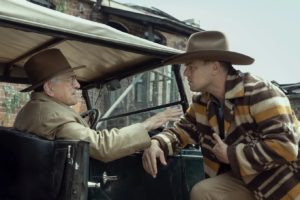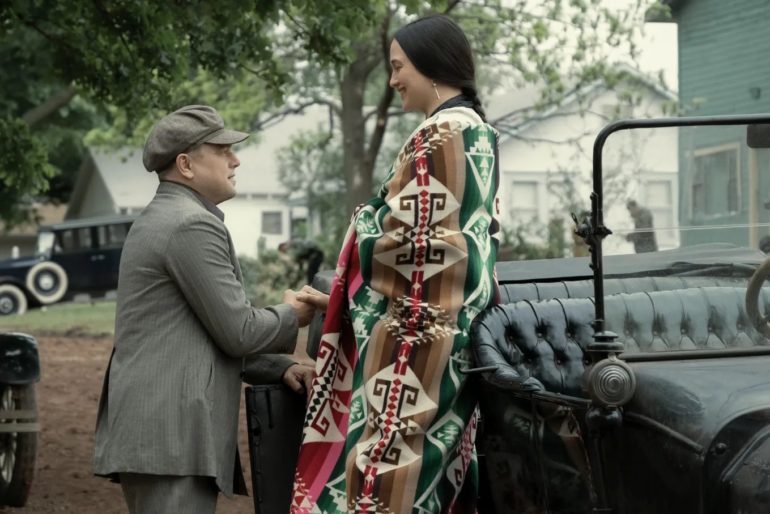$200 million on a tale of systemic greed, murder and racism? That’s the Scorsese effect. Very clearly making one for him (He’s 80; they’re all gonna be for him from now on), and taking full advantage of Apple Films’ largesse, Martin Scorsese has crafted another late gem to sit alongside The Irishman as an unofficial pair of treatises on American regret. It boasts a hefty price tag, but you’ve got a lot of movie for your buck.
Adapted from David Grann’s non-fiction book (by Scorsese and Eric Roth), a titanic investigative reconstruction of a most horrendous crime, Killers of the Flower Moon premieres at a Cannes Film Festival ripe with similar themes of the evil man does to his neighbour. After the one-two Holocaust sucker punch of Steve McQueen’s Occupied City and Jonathan Glazer’s The Zone of Interest, in comes Scorsese with Killers… to remind you that you needn’t travel so far from home to find grave systemic abuses from the past. The murder of prominent members of the oil-rich Osage nation in northeastern Oklahoma in the 1920s led to an investigation was was to prove an early breakthrough for the then-infant FBI, and shows that greed was good long before Reaganomics. The film opens with a funeral, less for a person than for a way of life, as the Osage people mourn the loss of their traditions to the allure of wealth provided by their newly-tapped oil-rich lands. We witness a group of Osage men discover a gushing oil well. As they dance and holler at their newfound liquid wealth, Scorsese shoots them in slow motion, reminiscent of a scene in which locals watch an irradiated fire blaze at the nuclear power plant in Johan Renck’s Chernobyl. In both cases, neither group is aware they have been bathed in death.
For all the idiosyncrasies Scorsese could portray from that era, the sight of poor whites serving upmarket Osage folk is a poignantly grim reminder that wealth becomes discriminatory. That kind of power corrupts, and the allure of that power brings WWI veteran Ernest Burkhart (Leonardo DiCaprio, a forced scowl hiding gradually-revealed depths) to his family cattle ranch in the Osage lands. His uncle King Hale (Robert De Niro, all subtle menace soundtracked by Foghorn Leghorn) and brother Byron (Scott Shepherd, weaselly effective) are in awe of their wealthy neighbours. So awestruck are they, in fact, that a murderous, infectious, and even eugenic plot is already afoot. They put Ernest to work as a cabbie in the local city, where fate and greed conspire for him to meet Mollie Kyle, one of the wealthiest heiresses to the oil monies. For this part, Scorsese had to convince Lily Gladstone to reconsider leaving acting to take the role. Anyone who saw Kelly Reichardt’s Certain Women knew Gladstone was a talent to watch, but her absence since was more notable still. After this, she’s back on track, giving a marvellous performance balanced between protective confidence and humane vulnerability. Mollie enjoys her newly-privileged life, but is susceptible to the charms of simple or malicious folk like Ernest (It’s always been a testament to DiCaprio that he goes against his looks to play unlikeable so frequently). Mollie represents the tragedy of the Osage in Killers of the Flower Moon; they wished to use their wealth to live in comfortable peace, but seductive others decided they wanted a slice of that pie.
 To convey that tragedy, Scorsese draws from masters past and present yet again, but always putting his spin on those influences. The obvious antecedent to this would be There Will Be Blood, with oil and greed pouring from every pore here; an older Daniel Plainview would have got on just fine with De Niro’s King. Many a shot recalls Terrence Malick (Days of Heaven being an obvious touchstone, given the film’s Midwestern setting), and at least a couple of moments nod to films in DiCaprio’s back catalogue (“J. Edgar Hoover? No, I don’t know him”). Yet for all the period trappings, the racing camera and pinball editing of his best fare are present and correct. This is the 1920s presented in a Goodfellas style. Indeed, parallels can be drawn between the Burkhart/Hale plot to take over the oil fortunes of Mollie and her sisters, and the mob’s infiltration of Las Vegas in Casino. Both that film and Killers of the Flower Moon capture moments in time, with the inception of a country’s succumbing to its worst impulses. The 1920s oil boom and the 1980s stock bubble ended when that greed got out of hand, but the lesson of both eras, and both films, is to remind you how many people lost so much. As the camera races around Ernest and Mollie’s new home like it’s the basement kitchen of the Copacabana, Scorsese brings his gift for capturing the grotesqueness of American excess back in time. It’s often overwhelming in its imagery and commentary; a couple of moments with an owl are prime for GIF-fing.
To convey that tragedy, Scorsese draws from masters past and present yet again, but always putting his spin on those influences. The obvious antecedent to this would be There Will Be Blood, with oil and greed pouring from every pore here; an older Daniel Plainview would have got on just fine with De Niro’s King. Many a shot recalls Terrence Malick (Days of Heaven being an obvious touchstone, given the film’s Midwestern setting), and at least a couple of moments nod to films in DiCaprio’s back catalogue (“J. Edgar Hoover? No, I don’t know him”). Yet for all the period trappings, the racing camera and pinball editing of his best fare are present and correct. This is the 1920s presented in a Goodfellas style. Indeed, parallels can be drawn between the Burkhart/Hale plot to take over the oil fortunes of Mollie and her sisters, and the mob’s infiltration of Las Vegas in Casino. Both that film and Killers of the Flower Moon capture moments in time, with the inception of a country’s succumbing to its worst impulses. The 1920s oil boom and the 1980s stock bubble ended when that greed got out of hand, but the lesson of both eras, and both films, is to remind you how many people lost so much. As the camera races around Ernest and Mollie’s new home like it’s the basement kitchen of the Copacabana, Scorsese brings his gift for capturing the grotesqueness of American excess back in time. It’s often overwhelming in its imagery and commentary; a couple of moments with an owl are prime for GIF-fing.
The actions of these characters are excessive by nature, and Killers of the Flower Moon has some excesses of its own. Complaints about its 3-hour, 24-minute runtime seem moot compared to the length of The Irishman, but the third act does see a drop in the pace. This feels deliberate on the part of Scorsese and the ever-nimble editing of Thelma Schoonmaker. As the U.S. government finally hears the Osage’s pleas for investigations into the ongoing trail of blood, they send in the newly-formed Feds (led by a solid Jesse Plemons), and the film takes on a mournful quality, as if preparing for a tragedy to befall all and sundry. Indeed, the Burkharts/Hales prey on the weaknesses of the Osage’s physicality, with the diabetic Mollie confined to bed while being slowly poisoned. The absence of Gladstone from the thick of the action is notable, but even as the pace slows, Scorsese and DoP Rodrigo Prieto keep the focus on the end of things. Fires burn bright, sunshine days turn to mouldy ochres, and Ernest is torn between seeing the plan through and saving what little love he has in his life. A couple of notable cast members are surprisingly reduced to extended cameos, but the main players (Gladstone and De Niro in particular) are excellent value.
Killers of the Flower Moon is a film torn between guilt and anger; the anger is in the energy, the guilt lies in the increasingly intricate and sinister narrative (Again, the length of the film reflects the exhaustive work in Grann’s book). Yet, the film ends inventively, with the best ending coda you’ve ever seen, and a final burst of hopeful colour and music from the Osage themselves. This is why The Irishman could never be Scorsese’s swansong; for all his gangsters, murderers and shysters, he’s still a man invested with hope. Killers of the Flower Moon ends on a hopeful note because that’s all any of us have, and the proceeding three-plus hours show us was happens if we lose that. The story is worthy enough to avoid accusations of formal indulgence, but future viewings will reap rewards. And that’s that.

